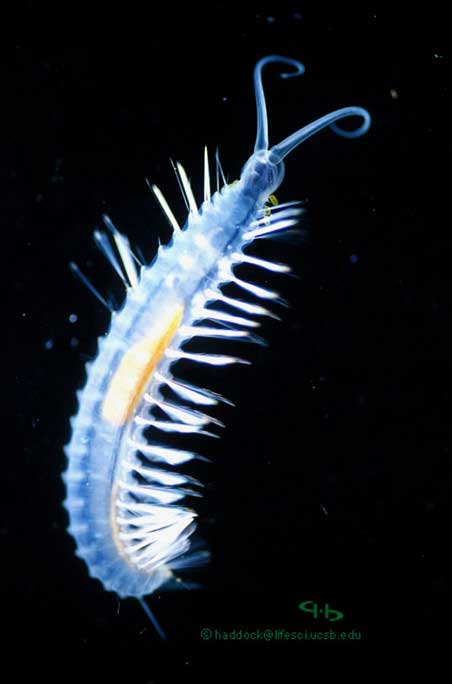'Dracula' Fish and Bombardier Worm Make Top 10 List

A "dracula" fish with canine-like fangs, a worm that launches glow-in-the-dark bombs and a psychedelic frogfish are among the Top 10 new species discovered in 2009, scientists just announced.
The International Institute for Species Exploration at Arizona State University and an international committee of taxonomists selected the species from around the world for the annual New Species list.
"Committee members had complete freedom in making their choices and developing their own criteria, from unique attributes or surprising facts about the species to peculiar names," said Quentin Wheeler, director of the International Institute for Species Exploration at Arizona State University and an entomologist in the School of Life Sciences.
Here are the Top 10 winners:
- Dracula fish: The minnow fish, called Danionella dracula, was found in a stream in Kachin State, Myanmar. The males of the species sport canine-like fangs for sparring with other males, likely over territory. Their lower jaws can open to a wide degree and form an angle of 45 to 60 degrees with the main body axis. This is the first record of oral teeth-like structures being found in the Cyprinidae, the largest family of freshwater fishes.
- Psychedelic frogfish: A bizarre new species of frogfish called Histiophryne psychedelica was discovered in Ambon and Bali, Indonesia. Its body is covered in a psychedelic orange-and-white swirly pattern, interrupted only by its piercing teal-colored eyes. This pigmentation could help the fish blend in among colorful, venomous corals on the seafloor in the area, scientists say.
- Golden orb spider: Called Nephila komaci, the spider is the first species in the Nephila genus to be described since 1879, Nephila spin the largest webs known, often greater than 3.3 feet (1 meter) across. The females of this spider grow to 1.5 inches (3.8 cm) in body length, with a leg span of 4 to 5 inches (10 to 12 cm). That dwarfs the males, which are on average five times smaller.
- Killer sponge: This carnivorous deep-sea sponge called Chondrocladia (Meliiderma) turbiformis, was found to display a special type of whirl-shaped spicule, now called trochirhabd.
- Bombadier worm: Discovered with undersea robots off the central coast of California in Monterey Bay, Swima bombiviridis releases glow-in-the-dark "bombs" when threatened. The balloon-like bombs, which are made from modified gill parts, illuminate for several seconds with green bioluminescence and likely deter distract predators.
- Insect-eating slug: Discovered in Pak Phanang Bay in the Gulf of Thailand, this sea slug (Aiteng ater) eats bugs, which is unusual since nearly all other sea slugs in the group called sacoglossans eat algae and a few specialize in gastropod eggs. The newly described slugs appear as small black blobs.
- Electric fish: Called Gymnotus omarorum, or its common name Omars' banded knifefish, the species was named to honor Omar Macadar and Omar Trujillo-Cenoz, pioneers in the anatomical and physiological study of electrogenesis in the Gymnotus genus of fish.
- Pitcher plant: Nepenthes attenboroughii produces one of the largest pitchers known, each the size of an American football. The carnivorous plant traps insects in the fluid contained in the pitchers. Endemic to the island of Palawan, Philippines, the plant is known only from a single locality and the authors of the Top -10 list suggest it should be listed as critically endangered.
- Odd yam: This "udderly weird yam," or Dioscorea orangeana, was found in Madagascar. Unlike most edible Malagasy yams, this one has tubers with several lobes, rather than just one., that hang down as if an udder.
- Phallic mushroom: Just 2 inches (5 cm) long, this mushroom grows on wood and curves downward instead of upward. The Freudian fungus, now called Phallus drewesii after herpetologist Robert Drewes from the California Academy of Sciences, belongs to a group of stinkhorn mushrooms that give off a foul, rotting meat odor. It was discovered on the African island of São Tomé.
"Charting the species of the world and their unique attributes are essential parts of understanding the history of life," Wheeler said. "It is in our own self-interest as we face the challenges of living on a rapidly changing planet."
Wheeler advocates a new generation of cyber-tools and Web resources that could vastly accelerate the rate at which humans discover and describe species.
- Gallery: Bizarre Frogs, Lizards and Salamanders
- Top 10 Beasts and Dragons: How Reality Made Myth
- 10 Animal Senses Humans Don't Have
Get the world’s most fascinating discoveries delivered straight to your inbox.
Jeanna Bryner is managing editor of Scientific American. Previously she was editor in chief of Live Science and, prior to that, an editor at Scholastic's Science World magazine. Bryner has an English degree from Salisbury University, a master's degree in biogeochemistry and environmental sciences from the University of Maryland and a graduate science journalism degree from New York University. She has worked as a biologist in Florida, where she monitored wetlands and did field surveys for endangered species, including the gorgeous Florida Scrub Jay. She also received an ocean sciences journalism fellowship from the Woods Hole Oceanographic Institution. She is a firm believer that science is for everyone and that just about everything can be viewed through the lens of science.


